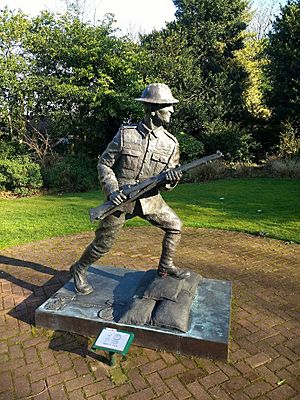Runcorn War Memorial facts for kids
Quick facts for kids Runcorn War Memorial |
|
|---|---|

Runcorn War Memorial
|
|
| Location | Runcorn, Cheshire, England |
| OS grid reference | SJ5089982091 |
| Built | 1920 |
| Architect | James Wilding |
| Governing body | Halton Borough Council |
|
Listed Building – Grade II
|
|
| Designated | 15 September 2016 |
| Reference no. | 1437933 |
| Lua error in Module:Location_map at line 420: attempt to index field 'wikibase' (a nil value). | |
The Runcorn War Memorial is a special monument built to remember the brave soldiers from Runcorn who died fighting in wars. It was first shown to the public on Remembrance Sunday in 1920. This started a tradition of holding services there every year in the afternoon.
Later, in 1948, the memorial was updated. The names of those who died in the Second World War were added. Even more names were added later on a stone, remembering people lost in more recent conflicts. The memorial has a tall cross made of white stone, standing on a base with steps. The names of the fallen soldiers are carved on a wall behind the cross. This important memorial is officially protected as a Grade II listed building.
Contents
About the Memorial's History
The Runcorn War Memorial stands in a small garden. You can find it where Greenway Road, Weston Road, and Moughland Lane meet in Higher Runcorn. A person named James Wilding designed it.
The memorial was first shown on November 14, 1920. Important people like Colonel William Bromley Davenport, who was the Lord-Lieutenant of Cheshire, and R. H. Posnett, a local council leader, were there.
On November 7, 1948, the memorial was rededicated. This was when the names of those who died in the Second World War were added. Later, another stone was put in place. It has the names of people who died in conflicts after the Second World War.
What the Memorial Looks Like
The memorial is made from white granite stone. This stone came all the way from Kit Hill Quarry in Callington, Cornwall. The main part is a Latin cross, which is a type of cross with a longer bottom arm. The tall part of the cross is about 3.5 meters (about 11.5 feet) high.
The cross stands on an eight-sided base, called a plinth. This base sits on three eight-sided steps. At the bottom of the cross's tall part, there are decorative curved shapes. The whole memorial is in a small garden on a paved area. You can walk up to it from the road using steps.
On the side of the base facing the road, it says "FOR OUR SAKE." On the left side, it says "1914," and on the right, "1918." These dates are for the First World War. The top step also has "1939–1945" carved into it, which are the dates for the Second World War.
Behind the cross, there is a wall made of sandstone. This wall is split into five parts by six stone pillars. Each part of the wall has a marble plaque. These plaques list the names of 361 local soldiers who died in the First World War. The pillars themselves have plaques with the names of 119 soldiers who died in the Second World War. The granite stone in front of the cross lists the names of those lost in more recent conflicts.
Why the Memorial is Important
The Runcorn War Memorial was officially recognized as a Grade II listed building on September 15, 2016. A Grade II listing means a building is "of special interest." It's the lowest of three levels of protection, but it still means the building is important.
This memorial is important for a few reasons:
- Historic Interest: It helps us remember the sad impact of world events on the local community. It shows the sacrifices made by people from Runcorn in the wars of the 20th and 21st centuries.
- Architectural Interest: It's a tall and impressive cross. It stands on a wide platform designed for special ceremonies. The memorial wall behind it also adds to its design.
War Memorial Garden
Across from the memorial cross, there is a special garden. In this garden, you can see a statue of Thomas Alfred Jones. He was from Runcorn and was awarded the Victoria Cross, which is the highest military award for bravery.


